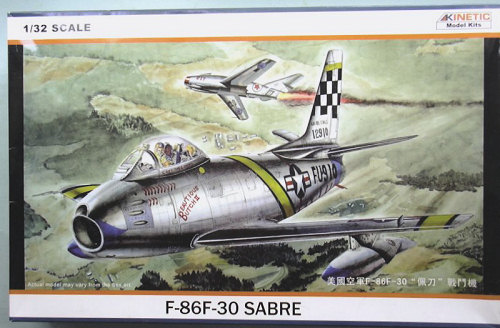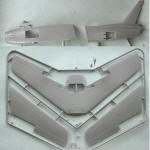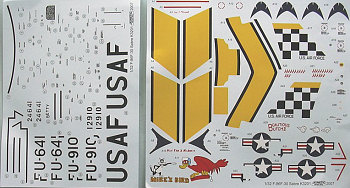
| KIT: | Kinetic 1/32 F-86F-30 Sabre |
| KIT #: | K3201 |
| PRICE: | $36.95 MSRP |
| DECALS: | Two options |
| REVIEWER: | Tom Cleaver |
| NOTES: | New mold |

| HISTORY |
The North American F-86 "Sabre," like its predecessor, the P-51D Mustang, was fortuitous in its developmental history, and is one of those aircraft for which it can be said that had it not existed, history would be written differently today. The Sabre is definitely among the Top Ten most significant fighter aircraft in history.
Fortunately for the United States, the Nazis were stupid enough to chase Edgar Schmued from Germany in 1938 with their racial policies. The immediate result two years later was the P-51 Mustang, which resulted from a design he had been toying with while working at Messerschmitt - his Mustang was more responsible than any other Allied fighter for the aerial destruction of Nazidom; furthermore Schmued had no difficulty reading the captured German technical papers which discussed the advantage of the swept wing for jet powered aircraft as a way of delaying the onset of compressibility and therefore increasing speed; he had also been in attendance at the Volta Conference in 1935 where Buseman presented his paper on the theoretical superiority of swept wings in high speed flight. The result was the F-86 Sabre.
Unofficially, the Sabre was the first supersonic aircraft, achieving a speed just in excess of Mach 1 in a dive two weeks before Chuck Yeager "broke the sound barrier" in the Bell X-1. The two aircraft in many ways were intertwined, because it was the research performed by the X-1 that led to the creation of the "all flying tail," which greatly eased an aircraft's penetration of the sonic barrier. The Sabre was the first operational aircraft to which this was fitted, and as a result, it was faster, and more importantly more controllable at high speed, than its Russian opponent, the MiG-15.
The F-86 was first ordered by the Air Force on August 30, 1944. At that time the design had a strong similarity to what would emerge from Republic's design department as the F-84 Thunderjet. Fortunately, in August 1945 Lee Atwood and Ray Rice were willing to listen to Schmued's descriptions of the German research papers before they were officially translated. Armed with this information, Atwood went to the Air Force and got a year's delay on the delivery date of the XP-86, time enough to add in the swept wings. It was likely the most useful and important delay in aviation history. Had this not happened - had the F-86 come out of the shop looking like a slimmed down version of its naval counterpart, the FJ-1 Fury - the results of the aerial battles over Korea a few years later would have been very different indeed.
The F-86A Sabre had only been operational for a year when it went to war. The appearance of the MiG-15 over the Yalu River in North Korea in early November 1950 sent shivers through the Air Force - the unknown Russian jet was superior to everything in the inventory other than possibly the Sabre. Within a month, the 4th Fighter Interceptor Wing - the descendant of the Eagle Squadrons and the 4th Fighter Group of World War II fame - was flying combat missions out of Suwon, Korea. For the next year, a force of Sabres that was never greater than 35-40 operational aircraft held off a Communist air command of several hundred jet fighters. The F-86A was followed a year later by the F-86E with the "all flying tail," and a bit less than a year after that by the F-86F which had an uprated engine and an extended wing leading edge without slats, for upgraded high speed and higher-altitude performance.
It is alleged that the Sabre achieved a kill ratio of 12.5:1 against the MiG-15. This has since been lowered to around 4.5:1 in the light of access to Soviet records after the end of the Cold War, and could be as low as 3.2:1 - still a very respectable score. In fact, the MiG-15 was generally superior to the F-86 above about 38,000 feet and could top out at 50,000 feet, which was superior to the Sabre's operational ceiling, and was always at least the Sabre's equal in climb and turn radius. What won the war for the Sabres was the edge provided by the greater skill and experience of its pilots, many of whom were aces of the Second World War, and all of whom were better-trained than their Communist opponents.
| THE KIT |
 The Sabre was first done in 1/32 scale by Hasegawa in 1972, and that has been
the only kit in the scale since until the advent of this new kit from Kinetic.
The Hasegawa kit is a long-wing F-86F-40, which means a modeler has to perform
some surgery to create a Korean War F-86. Additionally, there are accuracy
issues with the size of the cockpit and overall shape of the canopy. (Editor's
note: Because there are so many parts and showing them all would make for a tiny
image, I've just shown the fuselage and wings. In a case like this, it might be
better to have had a scan of the parts layout from the instruction sheet)
The Sabre was first done in 1/32 scale by Hasegawa in 1972, and that has been
the only kit in the scale since until the advent of this new kit from Kinetic.
The Hasegawa kit is a long-wing F-86F-40, which means a modeler has to perform
some surgery to create a Korean War F-86. Additionally, there are accuracy
issues with the size of the cockpit and overall shape of the canopy. (Editor's
note: Because there are so many parts and showing them all would make for a tiny
image, I've just shown the fuselage and wings. In a case like this, it might be
better to have had a scan of the parts layout from the instruction sheet)
This new kit from Kinetic is interesting on several levels. First, it is obviously a pantograph of the Academy 1/48 F-86F-30. However, it is more of a “limited run” kit, with thick parts, thick sprues and gates, and soft surface detail. Fortunately, the Academy original is an accurate start, so the kit is a good F-86F-30.
Much ado was made of the surface detail of this kit when the first pictures were made available on the internet. Looking at those pictures, I was expecting a plastic abortion like the godawful Dragon P-51D. I was hoping I’d be wrong and the kit would be about at the same level of surface detail as the Trumpeter F-100D - which I have found from examining two real F-100Ds out at Chino is not as overdone as some “experts” have declared it to be. Well, the good news is that the surface detail of this F-86 is even lighter than that of the Trumpeter F-100. In areas, it seems to disappear almost, and the only place where it is “heavy” is in the center section of the wings. Guess what? This looks remarkably accurate when compared to the surface detail of the two F-86s out at Chino. Interestingly enough, that “heavy” detail in the wing is an accurate representation of the bazillion half-inch countersunk Phillips-head screws that are found in that section of the wing! As to the rest of the surface detail, it looks very much like the surface detail of these airplanes, neither of which is as shiny, slick and smooth as the “experts” all proclaim they should be.
Test fitting of the major parts shows that there are no huge issues in assembly, other than a need to cut all parts off the sprues with a razor saw, due to the thickness of the sprue gates. The kit provides the two different versions of drop tank carried, as well as the later Sidewinder missile and rail.
Decals are for Joe McConnell’s “Beautious Butch” and for “Mike’s Bird.” The decals look to be useable, and include the yellow ID stripes carried by Korean Sabres.
 My only real complaint
about the kit is the canopy, which has the molded-in radio antennas as raised
detail inside the canopy. This would be hard to get rid of. Fortunately,
looking at the canopy from the outside, it is not overly apparent and I for one
will be able to live with it. The cockpit is sparse in detail, but Jef
Verswyvel of Avionix told me when I spoke to him at the Nats that he was going
to revise his resin cockpit for the Hasegawa kit to fit this kit. Also, Harold
Offield - who makes the most accurate F-100 seat - is currently working on a
detailed seat for the Sabre. Both these aftermarket items should be available
by mid-September, which is about the time this kit will be widely available.
My only real complaint
about the kit is the canopy, which has the molded-in radio antennas as raised
detail inside the canopy. This would be hard to get rid of. Fortunately,
looking at the canopy from the outside, it is not overly apparent and I for one
will be able to live with it. The cockpit is sparse in detail, but Jef
Verswyvel of Avionix told me when I spoke to him at the Nats that he was going
to revise his resin cockpit for the Hasegawa kit to fit this kit. Also, Harold
Offield - who makes the most accurate F-100 seat - is currently working on a
detailed seat for the Sabre. Both these aftermarket items should be available
by mid-September, which is about the time this kit will be widely available.
I like the fact that the kit provides a substantial metal weight, which will guarantee nose sitting even if you decide to include the engine - which will need a lot of work - in your finished model.
| CONCLUSIONS |
The Sabre is easily my favorite jet, and this new kit from Kinetic will fill the need for an updated and accurate model of this famous fighter. At an MSRP of $36.95, it represents good value. There are 1/32 aftermarket decals available (that I know of) from Cutting Edge for those who want more detail and variation in the markings for their kit. I suspect I will do more than one of these. I am definitely looking forward to their recently-announced 1/32 F-84E/G.
August 2007
Review kit provided by Stevens International.
If you would like your product reviewed fairly and quickly by a site that has around 400,000 visitors a month, please contact me or see other details in the Note to Contributors.